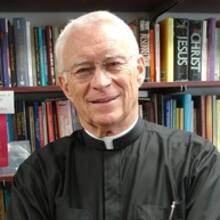After Life
Icons of Hope, John Thiel’s creative effort to explore Christian belief in eternal life, is clearly the work of a major theological thinker. Focusing on the eschata, the classical four last things—heaven, hell, death and judgment—Thiel rejects Kant’s position on the limitations of knowledge and wants to move beyond Rahner’s “hermeneutical modesty” in limiting what we might suggest about the life enjoyed by the blessed dead to a silence respectful of the divine mystery. Instead he takes the doctrine of the bodily resurrection as an interpretative guideline and uses several other Catholic doctrines to develop a much more imaginative, “thicker” eschatology, while acknowledging that it remains a work of meaningful speculation.
Departing from the traditional view that beatitude consists in the eternal contemplation of God in the beatific vision, Thiel develops an idea of the 18th-century American theologian Jonathan Edwards to suggest that the blessed dead are indeed active, even busy, though he refines it to imagine them involved in the ongoing work of forgiveness, healing rifts that exist in the communion of saints, that network of relationships in Catholic theology that binds the living and the dead together in the one body of Christ. Just as the risen Jesus continues his work of reconciliation in the resurrection appearances, so the blessed dead continue to engage in virtuous action, overcoming the effects of sin lingering in themselves and others; they fill up, so to speak, what was revealed in the particular judgment when they were unresponsive to grace. In this way the Last Judgment, rather than being redundant or anticlimactic, completes their participation in the divine plan of salvation. Emphasizing the distinction between the particular and general judgment also leads Thiel, like Joseph Ratzinger/Pope Benedict, to reject the idea of resurrection at the time of death. This rethinking of the difference between the particular and general judgments that shows the faithful departed themselves contributing to the final realization of God’s kingdom may be the greatest strength of the book.
While highly speculative, Thiel’s vision is both imaginative and deeply Catholic. His fascinating analysis of Catholic and Protestant artistic representations of the Last Judgment—by artists like Federico Zuccari, Giotto di Bondone, Michelangelo Buonarroti, Lucas Cranach the Younger and Albrecht Dürer—enriches his narrative. Against the Protestant “strong” doctrine of grace, leading to the doctrine of predestination in Luther and Calvin, Thiel stresses the Catholic insistence on cooperating with grace, even if our cooperation is itself a work of grace.
He addresses head-on the diminished sense of personal sin today, and with it the doctrine of purgatory, which he attributes at least in part to the post-conciliar emphasis on the wide availability of God’s grace. He shows how our identities are constituted by the social dimensions of both sin and grace, as the sins of our earthly lives, even our complicity in social or structural sin, continue to play out through history. And the last judgment shows how our lives are bound together, for better or for worse, even in the resurrection, reflecting the close linking of “forgiveness of sins” and “resurrection of the body” in the ancient creeds. Finally his analysis of how forgiveness works on both sides of death leaves at least open the possibility that God’s efficacious grace might yet save all.
Some of his points I find more problematic. The distinction he draws between what he calls a Pauline style of faith, a confidence that Christ’s resurrection annuls God’s judgment on sin, bringing believers into heavenly bliss in spite of their sinfulness, and a Matthean style of faith (though he finds it common to the Synoptics) which emphasizes judgment and personal response, expecting proof of discipleship and an ethical life, seems overdrawn. Paul also demands conversion of life and moral living, as witness his First Letter to the Corinthians or his exclamation in Rom 6:1, to which Thiel admittedly gives a Catholic reading: “Should we persist in sin that grace may abound? Of course not!” And Thiel avoids the prior question of whether Jesus himself spoke of judgment.
Some will find controversial his characterization of pre-Second Vatican Council Catholic faith and spirituality as competitive. He argues that the example of the martyrs and later the ascetics led Christians to worry about their own spiritual lives. The eschatological anxiety their examples and the Matthean style of faith engendered, he says, played an important role in the development of the doctrine of purgatory as a way of mitigating the resulting “competitive style of religion” by extending a quasi-monastic vocation into the afterlife, thus allowing the laity more time for a satisfactory judgment on their lives. But Thiel has a point in calling attention to the “hierarchy of discipleship” that prized the clerical or consecrated life over that of the laity, a contrast that lasted in Catholic language until Vatican II.
Thiel’s “thick” eschatology, with the blessed dead still working for reconciliation, challenges the imagination but leaves me wondering what remains of the self prior to the resurrection of the body, the author’s citations from two medieval popes not withstanding. This is not an easy book to read, but because it opens up a new vision of the life to come, it is well worth the effort.
This article also appeared in print, under the headline “After Life,” in the January 6-13, 2014, issue.







